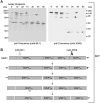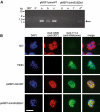Regulated maturation of malaria merozoite surface protein-1 is essential for parasite growth
- PMID: 20735778
- PMCID: PMC2995310
- DOI: 10.1111/j.1365-2958.2010.07324.x
Regulated maturation of malaria merozoite surface protein-1 is essential for parasite growth
Abstract
The malaria parasite Plasmodium falciparum invades erythrocytes where it replicates to produce invasive merozoites, which eventually egress to repeat the cycle. Merozoite surface protein-1 (MSP1), a prime malaria vaccine candidate and one of the most abundant components of the merozoite surface, is implicated in the ligand-receptor interactions leading to invasion. MSP1 is extensively proteolytically modified, first just before egress and then during invasion. These primary and secondary processing events are mediated respectively, by two parasite subtilisin-like proteases, PfSUB1 and PfSUB2, but the function and biological importance of the processing is unknown. Here, we examine the regulation and significance of MSP1 processing. We show that primary processing is ordered, with the primary processing site closest to the C-terminal end of MSP1 being cleaved last, irrespective of polymorphisms throughout the rest of the molecule. Replacement of the secondary processing site, normally refractory to PfSUB1, with a PfSUB1-sensitive site, is deleterious to parasite growth. Our findings show that correct spatiotemporal regulation of MSP1 maturation is crucial for the function of the protein and for maintenance of the parasite asexual blood-stage life cycle.
© 2010 Blackwell Publishing Ltd.
Figures








Similar articles
-
Processing of Plasmodium falciparum Merozoite Surface Protein MSP1 Activates a Spectrin-Binding Function Enabling Parasite Egress from RBCs.Cell Host Microbe. 2015 Oct 14;18(4):433-44. doi: 10.1016/j.chom.2015.09.007. Cell Host Microbe. 2015. PMID: 26468747 Free PMC article.
-
The merozoite surface protein 1 complex is a platform for binding to human erythrocytes by Plasmodium falciparum.J Biol Chem. 2014 Sep 12;289(37):25655-69. doi: 10.1074/jbc.M114.586495. Epub 2014 Jul 29. J Biol Chem. 2014. PMID: 25074930 Free PMC article.
-
A multifunctional serine protease primes the malaria parasite for red blood cell invasion.EMBO J. 2009 Mar 18;28(6):725-35. doi: 10.1038/emboj.2009.22. Epub 2009 Feb 12. EMBO J. 2009. PMID: 19214190 Free PMC article.
-
Merozoite surface proteins of the malaria parasite: the MSP1 complex and the MSP7 family.Int J Parasitol. 2010 Aug 15;40(10):1155-61. doi: 10.1016/j.ijpara.2010.04.008. Epub 2010 May 6. Int J Parasitol. 2010. PMID: 20451527 Review.
-
Plasmodium falciparum merozoite surface protein 1 as asexual blood stage malaria vaccine candidate.Expert Rev Vaccines. 2024 Jan-Dec;23(1):160-173. doi: 10.1080/14760584.2023.2295430. Epub 2023 Dec 27. Expert Rev Vaccines. 2024. PMID: 38100310 Review.
Cited by
-
Merozoite surface proteins in red blood cell invasion, immunity and vaccines against malaria.FEMS Microbiol Rev. 2016 May;40(3):343-72. doi: 10.1093/femsre/fuw001. Epub 2016 Jan 31. FEMS Microbiol Rev. 2016. PMID: 26833236 Free PMC article. Review.
-
FT-GPI, a highly sensitive and accurate predictor of GPI-anchored proteins, reveals the composition and evolution of the GPI proteome in Plasmodium species.Malar J. 2023 Jan 25;22(1):27. doi: 10.1186/s12936-022-04430-0. Malar J. 2023. PMID: 36698187 Free PMC article.
-
Cell biological characterization of the malaria vaccine candidate trophozoite exported protein 1.PLoS One. 2012;7(10):e46112. doi: 10.1371/journal.pone.0046112. Epub 2012 Oct 8. PLoS One. 2012. PMID: 23056243 Free PMC article.
-
Hardly Vacuous: The Parasitophorous Vacuolar Membrane of Malaria Parasites.Trends Parasitol. 2020 Feb;36(2):138-146. doi: 10.1016/j.pt.2019.11.006. Epub 2019 Dec 19. Trends Parasitol. 2020. PMID: 31866184 Free PMC article. Review.
-
Identification and characterization of the merozoite surface protein 1 (msp1) gene in a host-generalist avian malaria parasite, Plasmodium relictum (lineages SGS1 and GRW4) with the use of blood transcriptome.Malar J. 2013 Oct 30;12:381. doi: 10.1186/1475-2875-12-381. Malar J. 2013. PMID: 24172200 Free PMC article.
References
-
- Bergmann-Leitner ES, Duncan EH, Mullen GE, Burge JR, Khan F, Long CA, et al. Critical evaluation of different methods for measuring the functional activity of antibodies against malaria blood stage antigens. Am J Trop Med Hyg. 2006;75:437–442. - PubMed
-
- Blackman MJ, Holder AA. Secondary processing of the Plasmodium falciparum merozoite surface protein-1 (MSP1) by a calcium-dependent membrane-bound serine protease: shedding of MSP133 as a noncovalently associated complex with other fragments of the MSP1. Mol Biochem Parasitol. 1992;50:307–315. - PubMed
-
- Blackman MJ, Whittle H, Holder AA. Processing of the Plasmodium falciparum major merozoite surface protein-1: identification of a 33-kilodalton secondary processing product which is shed prior to erythrocyte invasion. Mol Biochem Parasitol. 1991;49:35–44. - PubMed
-
- Blackman MJ, Chappel JA, Shai S, Holder AA. A conserved parasite serine protease processes the Plasmodium falciparum merozoite surface protein-1. Mol Biochem Parasitol. 1993;62:103–114. - PubMed
Publication types
MeSH terms
Substances
Grants and funding
LinkOut - more resources
Full Text Sources
Other Literature Sources
Research Materials

